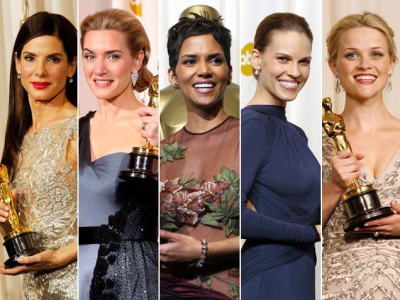Words| Lee Jones
As award season draws to a close, amateur film buffs and professional critics alike hold their breath in anticipation of the concluding ceremony of glitzy A-List stars and lengthy, cringe worthy acknowledgement speeches that is the Academy Awards. Focusing on the Best Actress nominees, it is clear that the Academy fell short of accurate representation in film this year. From Felicity Jones in The Theory of Everything to Rosamund Pike in Gone Girl, we can see that the Best Actress race will, unfortunately, be a predictable affair between five women of similar ethnic backgrounds. For all the controversy surrounding this year’s nominees, I think that it is important to trace the Academy’s treatment of the Best Actress category through the decades and illustrate how it has always been a contentious issue concerning its lack of racial diversity and, perhaps more subtly, its narrow scope of character roles for women.
The Academy Awards began in 1927 with Janet Gaynor crowned winner of the first Best Actress Oscar for not one, but three roles. In particular, her character in Street Angel was commended for her resistance against traditional female domestic roles. However, as the 1930’s progressed, Academy winners were predictably chosen on the basis of their conformity to societal values. For instance, the renowned silence era actress Mary Pickford won for her role in Coquette the following year. The premise of this film nowadays would be considered misogynistic and misinformed, with Pickford’s character forced to choose between the interests of her brutish lover and her over-protective father.
Notably, Gone with The Wind swept the Oscars in 1939 and Vivien Leigh was awarded for her performance as Scarlet O’Hara. Despite the film’s notorious criticism for its glorification of slavery and its anti-feminist notions, it paved the way for the first nomination and first win by an African American actress, Hattie McDaniel, in the Supporting category that year. That being said, as the 1940’s crept in, films returned to a conservative standpoint and any breach of the status quo or representation of minorities was forgone. A pattern of recurrent nominated actresses emerged, with Bette Davis and Katharine Hepburn as the most popular choices. The wartime settings of these films conditioned all female roles to the domestic home; where their dialogue and motivations centred on the wellbeing of their family and their estranged husbands at war.
By the 1950’s, film began to reinvent itself in order to compete with television. New cinematic techniques and thematic matters were introduced to the Academy each year. Best Actress winning roles pushed boundaries and created a sense of agency for women. Most importantly however, was the first African American nominee in the Best Actress Category in 1954 for Dorothy Dandridge. Just taking a moment to evaluate the time lapse between the first African American winner of the Supporting Actress Category in the 1930’s to the first nomination, not even for a winning role, for Best Actress in the 1950’s is shocking and evidently highlights the poor representation of ethnicity in the Academy Awards.
While the 50’s showed some signs of improvement, narratives about fallen women, prostitutes and single mothers pervaded film during the 60’s, transforming the Academy’s traditional perception of an award-worthy performance by a woman. Interestingly, Katharine Hepburn and Barbara Streisand tied for Best Actress in 1968 for their roles in The Lion in Winter and Funny Girl respectively. Consequently, Hepburn achieved the title of the first and only leading actress to win four Academy awards.
The beginning of New Hollywood in the 1970’s brought another reformation to the Best Actress category. The burgeoning genre of the rom-com paved the way for a multitude of nominations and winners that were previously unheard of. Most significantly was Diane Keaton’s win for Annie Hall for her portrayal of the kooky love interest of Woody Allen’s character. Ellen Burstyn’s nomination for her role as Chris MacNeil in the box office giant The Exorcist also marked the first time the Academy had acknowledged horror as a legitimate genre for recognition in this category.
The Academy Awards fell into a pattern of nominating similar roles and similar actress, most prominently featuring Meryl Streep and Susan Sarandon. Although she never received the golden statuette, Sigourney Weaver’s nominations for Aliens in 1986 and Gorillas in the Mist in 1988 became a pivotal moment in cinematic history because it extended the generic territory for actresses to perform in. Most shockingly, however, is the fact that it was not until 2001 that the first African American actress won for this category, Halle Berry in Monster’s Ball. While the early noughties included several nominations for minority groups, those that prevailed were, and remain still, predominantly white women.
This year, the Academy Awards have come under heavy scrutiny because of their poor representation of women and ethnic minorities in each category. The Award for Best Film Director is being contested between five males, only one of whom is not of European or American ethnicity (Alejandro G Inarritu) and for the first time in 19 years, the four highly publicised Acting categories for ‘Best’ are all contested by white nominees. Arguably, the spectrum of character roles for women has diversified and broadened possibilities for cinema, and yet one cannot overlook that the startling lack of ethnic diversity has never been more apparent.
The hashtag #OscarsSoWhite was trending worldwide following the release of the 2015 Awards nominations in January. Focusing on the history of Best Actress winners, it is clear that the Academy is in desperate want of reformation. Broadcasting to over 200 countries, the Oscars certainly play a part in how our world view is shaped and by alienating certain ethnicities, genders and particular roles, it raises the question of how damaging this misrepresentation will be for younger generations watching and for Western culture’s progression, on a whole.







